Stain or Finish?
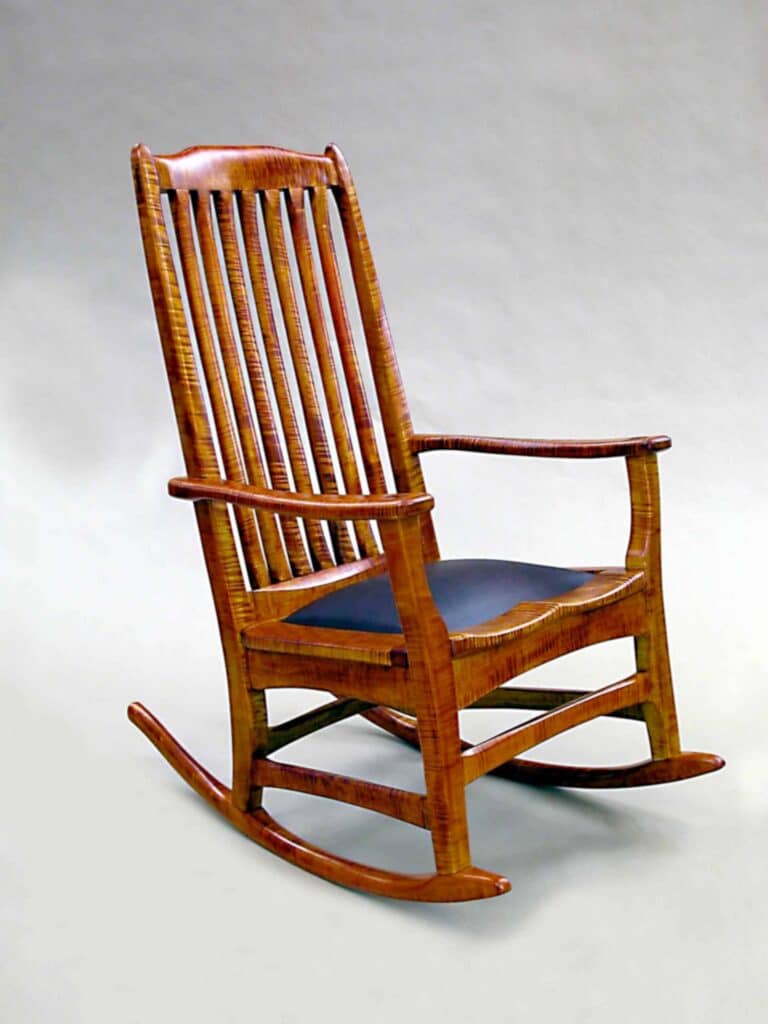
Having lived and worked in the US for over two decades I grew to know the obvious differences in words and terms used between American English and pronunciations and the English ways: sidewalk = pavement; pavement = road, carpark = parking lot and then you come to stain. Many US woodworkers refer to finish as stain which can get confusing because stain is mostly, not always, an added colour intended to change the colour and appearance of wood for a couple of reasons whereas finish is the surface treatment added to the wood to enhance the visual appearance and feel of the final surface and also to protect it from staining and discolouration through daily use.
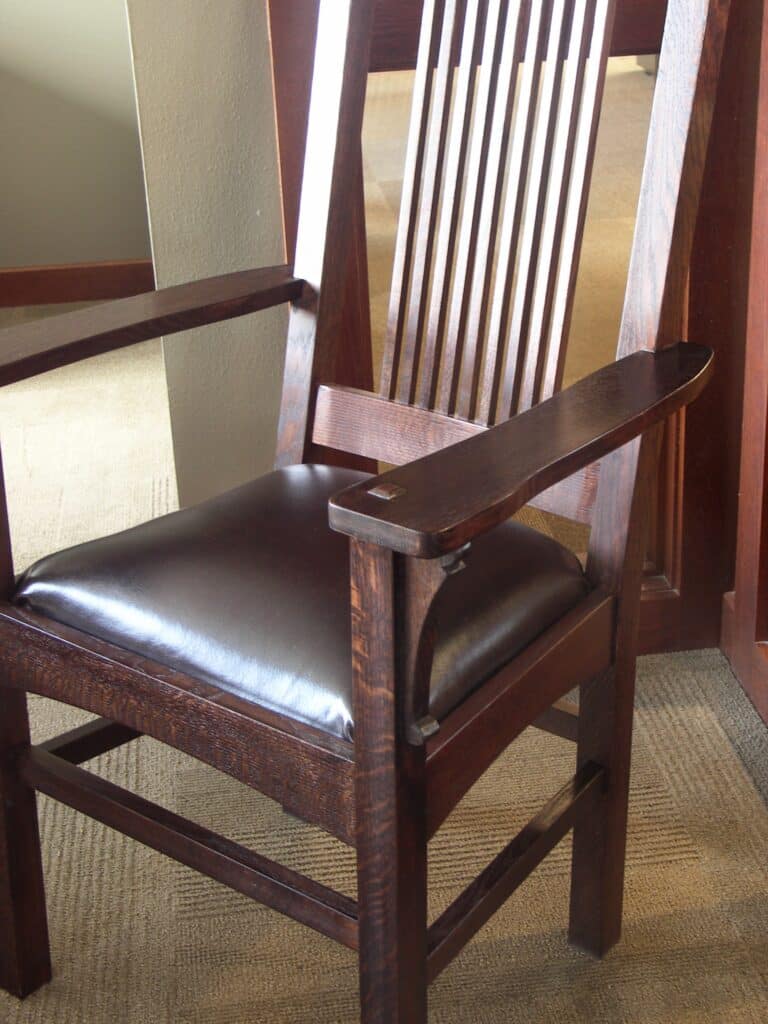
I rarely use stain on any of my projects these days, I want to rely on the wood itself and the way I arrange and integrate the natural colour, texture and diverse grain configuration as part of my overall composition. I had to adjust my thinking when I arrived in the USA to live and work because it seemed to me at least that it was ‘ingrained‘ in the majority of customers to request seeing a colour chart of stain options they could choose from. And stainining any any and all continents is no new thing. That being so, many want to match something they already exists in their home or office. We once made a whole office suite for a new county council office fit out of furniture pieces with all the pieces made from oak. The oak was ultimately distorted by stain to where its whole personality was lost to the then dominant stain. Yes, it was as per instructions, but I would not look to an impersonal council office for answers in design. The black or dark stain had nothing it needed to match to except some archaic past.
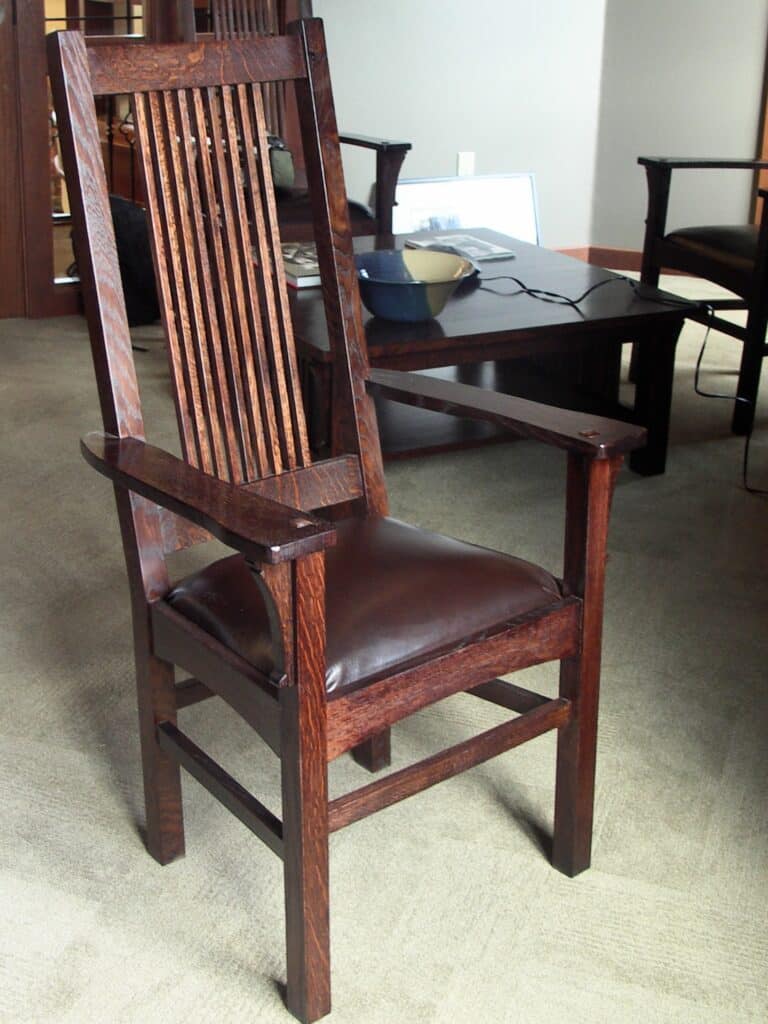
The names given rarely match any kind of wood; dark oak, medium oak and light oak gave nothing at all to do with the colouring of oak wood in the same way ‘walnut‘ stain is in no way comparable to say dark or black walnut. So why stain at all? Staining is not, of course, anything new. Go back through the past centuries and wood has been stained and with good reason. We see stain used a lot with woods like mahogany because the wood comes in a million shades of red and the patchwork-look is less attractive to the point that the contrasts are just too much. We used potassium dichromate as a chemical solution to age woods with tannins naturally present in woods such as oak and mahogany. Mix a teaspoonful in a cup of cold water and apply to the wood and the result is transformative. aging and darkening the wood immediately.
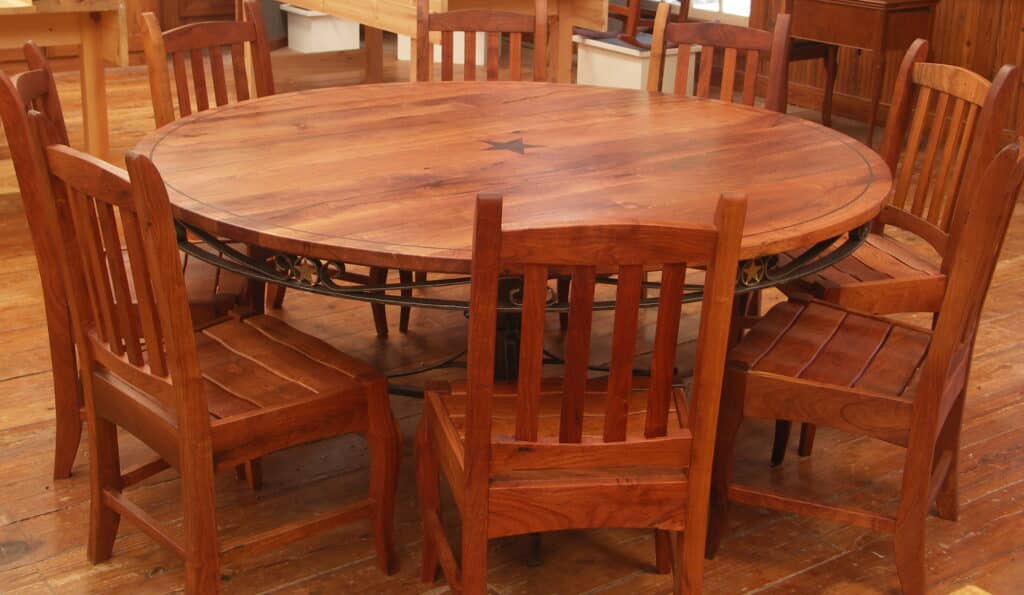
I designed the original rectangular table for a Texas customer in or around 1992. Customers wanted square and round versions too and inevitably we made extending versions as well. The chairs were my Texas design of which we sold hundreds of them for around $1200 a piece. Yes, they are a bit clunky, but they were also very popular because they were so Texanese. The ironwork undergirding the table was a part of my design but what’s hidden in some of the designs like this is the extendability so it went from eight chaors to twelve.
There is no stain on these mesquite pieces but they do darken by oxidation with time so I prewarned my customers that this would happen. No one ever objected.
This walnut table, made from some Texas walnut, was unstained too. My son Joseph made it when he was 19 years old and he made it to sell. Using Danish oil which is not relly an oil per see, the wood would darken considerably. Oil finishes darken any and all woods to some degree but without any stain being added.
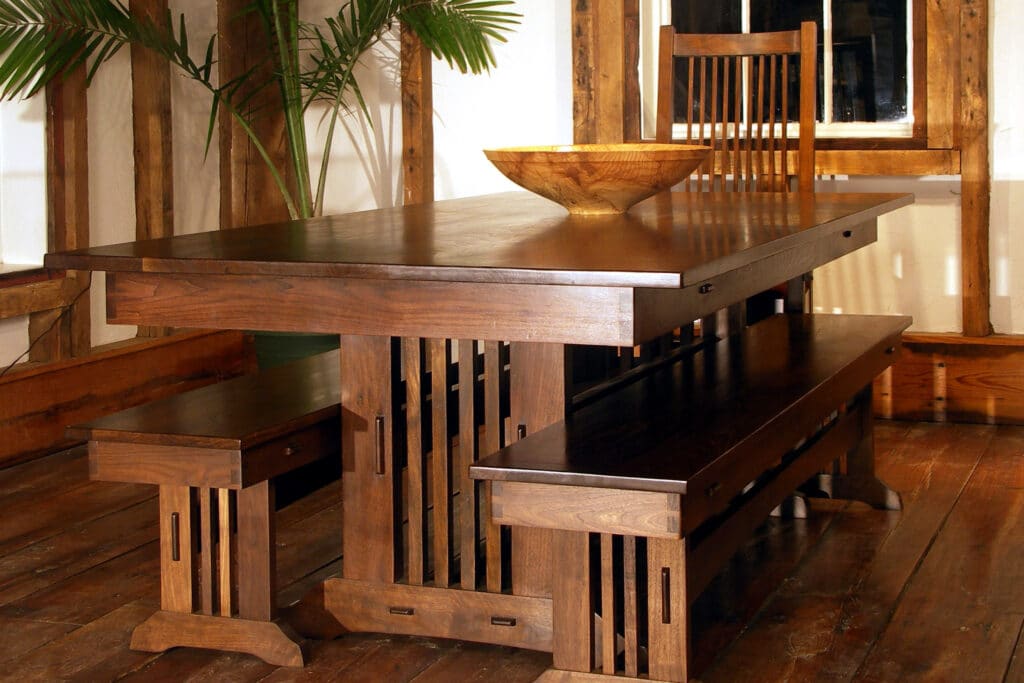
Staining and dying is an individual choice. Not many violins or cellos would be sold in the white and you will not see many played in a fully fledged orchestra. I think my lasts staining or dying came about 8 years ago but it does not mean I( would never do it. Some pieces can indeed be really enhanced and some woods look rubbish and undressed without help. Think maple, for instance. Even highly figured maple seems underdone without colour to increase the contrast of reverse and alternating grain patterns with some woods chatoyancy is everything.
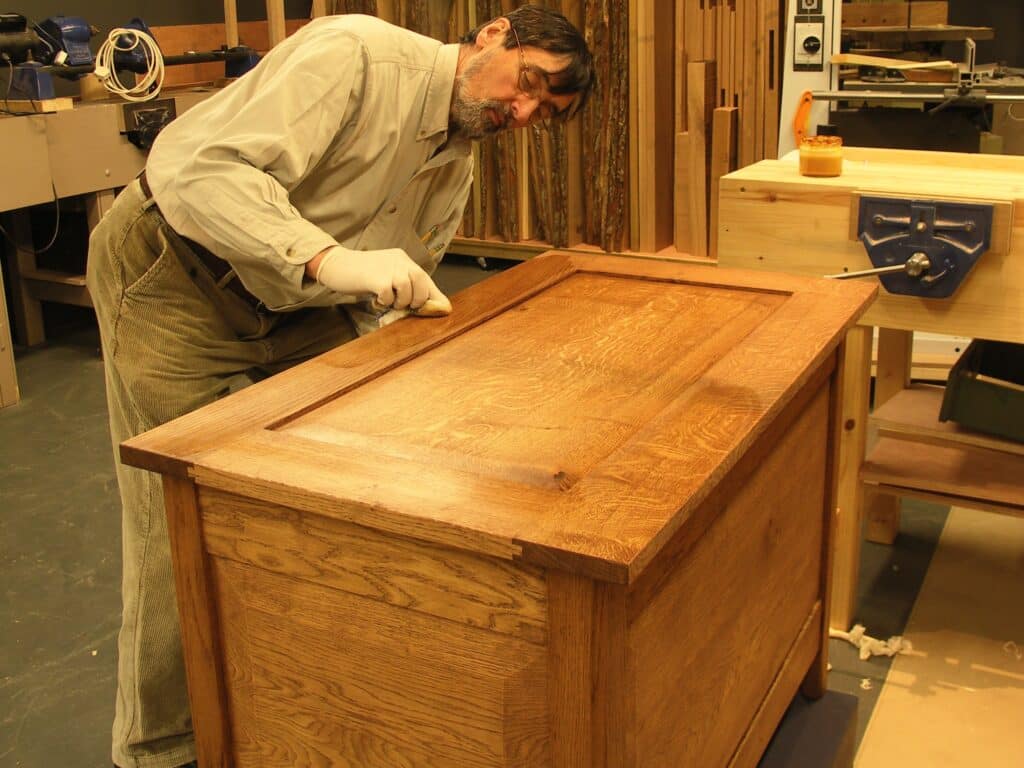
This chest above sold because they asked for stain and I gave it the coat they asked for.
This Stradivari violin was made somewhere around 1730 and was owned by him until he died in 1737. the woods used would all be white woods with no colour of particular note and would have yellowed by now had not colour been added to the varnish. Analyses showed that Stradivari used a penetrating oil that sank into the outer fibres of the maple back, bouts and the spruce top (front) this drying oil sealed the fibres in preparation for subsequent coats of varnish that formed the upper layer lying above the wood as a mix of oil, pine resin and added pigments.
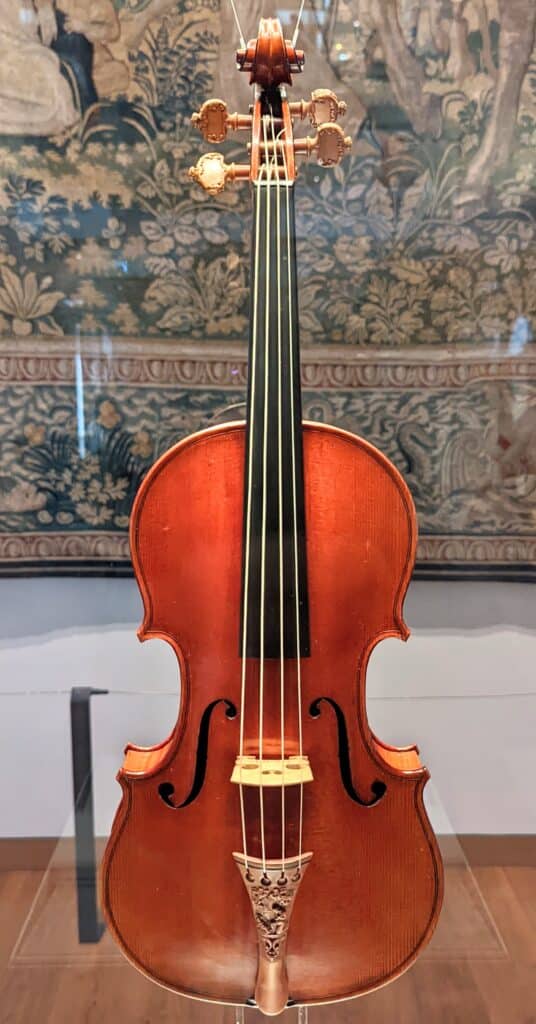



My favourite way of finishing most woods are an ethanol based dye if needed, oil and then paste wax. I tend to test these on an offcut first because, as you allude to, the name on the tin really has no reference colour in any known woods. The ethanol dyes seem to take nothing away from the wonderful patterns we see in the grain and the oil and wax give it a sheen that just makes me happy. The wax might be unnecessary but it does smell so good! Chatoyancy is now my new word of the month so thanks for that Paul!
Gel stains have been on the raise where I’m from for a while now amongst painters, and maybe it’s just the way they apply it, but it really seems to dull the grain dramatically, and while it does save them some time it’s a pretty lame thing to do, but that’s a carpenter gripe more then a furniture gripe. On furniture though I do use stain pretty regularly.
I might possibly use it on white and colourless woods as I said but anything with colour in the wood is now a nono for me. Looking at the natural ageing of woods I use such as ash, cherry, walnut oak and many others I think I am down to the rarest possibility of adding colour. The maple range of acers is the most likely because, in the straight-grained and often colourless versions, they don’t do very much by way of enhancing the work I’ve done. Bowed instruments for sure need it. But then I look at the sycamore cabinets I made for the kitchen and they seem quite stunning without being too flamboyant so who knows. Now dyeing wood is a different thing because it is not heavy pigment so somewhere, for some things, I would at the very least consider it. Definately will never use gell stains though. Not for me.
I almost never use commercial stains. On pine or maple I have experimented with using vinegar with steel dissolved in it to add color. It actually gives a wonderful color, although it can be slightly unpredictable. Aqua Fortis or Ferric Nitrate is a similar solution that is well known for use on maple flintlock stocks. I really like a simple oil varnish finish (I use tried and true brand) for most everything. The look and feel of it I just love, more time consuming to do though. I use a lot of milk paint as well. I really enjoy doing pieces with milk painted bases and oiled wood tops.
Thanks Paul. So far, the closest I’ve gotten to using a stain is to using garnet shellac. I like the color it produces on cherry.
Do you consider ebonizing wood and fuming with ammonia also to just be a form of stain?
For that pretty tiger maple rocker, did you just use some brown shoe leather dye in shellac to obtain that look? I really like tiger/flame maple and would like to duplicate that finish if it isn’t too difficult. Did you have a feel for how much shoe dye to add to the shellac? Of course, I would try sample pieces. Thanks.
One side note potassium dichromate contains hexavalent chromium, a known carcinogen. As a chemist, I’ve mostly (but not always) avoided working with it in the lab. Can it be handled safely? Sure. However, I wouldn’t want to bring it into my home or workshop. Beyond dealing with the aqueous solution, I’d also worry about trace wood dust from the piece if I (or any of the future owners) sanded it. Not sure how much there would be after washing it down. However, I personally have decided to avoid it myself. I worked with plenty of nasty and toxic and cancer causing reagents in my career and was always very careful. I try and minimize my exposure where I easily can. My two cents on the topic.
I have recently started woodworking and have been using birch plywood as my main material due to its stability, density and use friendliness. I find it takes well to a water based polyurethane finish. A problem which has started to occur on my table tops is that the finish has started to rub off over time, leaving an unsightly sticky residue. I was wondering whether using an osmo polyx oil on the tops while leaving the rest of the frame finished in polyurethane would be a good idea or a complete disaster. Can you use 2 different finishes on different components of the same project or is it just a bad idea? I’ve recently built a dovetailed mule chest all out of 15mm birch ply and was thinking of using polyx oil for the top while keeping the carcass and drawers in low gloss polyurethane. Any thoughts or advice would be appreciated.
I can’t really imagine a less “use friendliness.” than plywood no matter the quality, so I wonder why you say such a thing unless the cuts come primarily from machines. Plywood has its place in our world of mass-making and factorial production methods. It’s incredibly strong and of course, I use it for panels in place of real wood for that reason. As a wood for working with hand tools that is not the case. It’s hard and extremely unpleasant to plane, the outer veneers and edges especially edge-fracture and separation occurs for different reasons. Any slip of the plane or a sawcut out of alignment is often evident in the final outcome so great care is needed and it does change shape too. All woods take any finish well, and plywood is no better than real wood. I am trying to imagine any scenario where plywood would, could or should be used for a tabletop too and especially birch which is the most characterless plain wood of all.
Water-based polyurethane is basically plastic. It’s acrylic resin hidden behind terms we find more agreeable than solvent-based chemical finishes because we like to wash brushes in tap water but the plastic is eternally contaminating the waterways and seas for our ease. Water-based polyurethane is prepared from polyurethane, hydroxyl-containing acrylic resin, pigment, surface active agent, dispersing agent and deionized water according to the weight parts. Adding coats by layers should follow the maker’s instructions as leaving it too long results in separate layers that do not adhere well and usually end up peeling away in skins. The gumminess is often caused by acids in the human skin so many finishes react in a bad way on say desks and dining tables where hands rest for periods at a time. I have used water-based floor finishes that seem to hold up well for tables. Osmo polyx oil is a pleasant finish but not a hard or resistant finish in particular and in its list of resistance values it excludes spirit alcohol which tells you something like don’t drink whisky or use nail polish remover on it.
It’s funny you mention plywood Paul. Outside of bottom of drawers, back panels, and some things in the shop, I haven’t used it that much. Just finishing up a big project 4′ long x 24″ wide by 20″ tall (approx dimensions) for my nephew with lots of dovetails. It’s the first time I had wanted to have a table saw. I’m not going to buy one as it is literally the first project in 7 years where I have felt it would have been helpful. At some point, I came to realize that this is also the first project where I made it out of plywood (nephew’s choice of materials after we had talked about options – I’m not charging him so my labor wasn’t a consideration to what he wanted to use). Made me wonder if there is some connection between plywood and a table saw.
Thank you for the reply. As to user friendliness, I was referring to 2 main factors. Firstly, the large panel size which allows you to cut exactly to the width and length required and secondly the 4 flat faces which avoids the need to bring out a hand plane altogether.
My idea was to begin learning a few simple joinery techniques on panel products such as dowel joinery, box joints, dados and dovetails on plywood, albeit its characterless nature, before transitioning into the more expensive solid woods available where I live such as oak, walnut and beech. I had purchased a few sheets of birch ply before the prices shot up through the roof here in Europe. I make all my cuts with a circular saw and I find a high number of teeth on the blade and a strip of masking tape before making the cut help avoid chipping and blowout along the edges.
Initially, I was hesitant to attempt dovetails on plywood until reading your article on “reshaping my chisels” https://paulsellers.com/2022/06/reshaping-my-chisels/?pspopuphide=true where I found an example of a beautifully executed dovetailed chisel tray in what I believe to be birch plywood which showed me that it was in fact achievable with acceptable results.
An interesting point as to human skin oils and their effect on polyurethane finishes. I will keep searching for a suitable alternative, as a tabletop on which one cannot remove their nail polish before sipping on a dram of Lagavulin is an utter failure indeed.
Cheers, a big fan of your work.
I have a pre-made mixture, that is a combination of beeswax and boiled linseed oil. I combined both over a double boiler until the wax was melted, then gently stirred it as it cooled. The result is a spreadable paste, that is fairly easy to work into wood, and can be lightly polished.
So far I have used it on plane totes/knobs, and chisel racks etc. But I recently completed your dovetail box from the common woodworking courses, and it was a nice finish for that.
At one time this was one of the commonest finishes but it isn’t durable enough for modern life and is rather impractical, Duncan. We used to make it that way when I was in my teens.
Paul, I have often wondered, how was the very deep dark brown achieved on old pieces of oak/elm furniture? I am thinking about old coffers, chests and tables etc. that you often see in period properties etc. Would that have been potassium dichromate? I have heard some suggest a dye made from walnut husks or some say that it was done by fuming with ammonia?
I have also wondered about the rich even colour that you see on elaborate carved wooden screens etc. in churches, such as:
http://i472.photobucket.com/albums/rr87/rhys71/6_DSC7612_zpsfe7f979e.jpg?w=840
Would such an intricate piece have been fumed?
Well, oak will naturally darken over the decades and centuries anyway so that could account for fifty per cent of its darkness. Fuming with ammonia was and is readily available and that evens out the colouring so it was commonly used. Just a note though, in its intense form of 99% ammonia it is very dangerous and will stop you from breathing in split seconds so if anyone does go for fuming either know what’s safe and the safety protocols or go for q household sudsy ammonia. Ammonia will flatten the appearance of oak in the sense of dulling it. Fuming is the easiest to achieve evenness because nothing is applied; it’s just the fumes given off and exposing the wood to it. Usually, a tent or frame covered with plastic contains the fumes and the project. On large items it can be a whole room.
My wife and I made a first visit to the Ashmolean Museum in Oxford last year, the main reason was to see a superb exhibition of Pre-Raphaelite paintings and drawings. It also gave me a chance to see the Messiah Stradivari. The whole museum was stunning, the violin was truly beautiful and simple but, as a woodworker, I was most impressed by the two Stradivari guitars!
I didn’t realise had been made as early as that and so different from modern guitars.